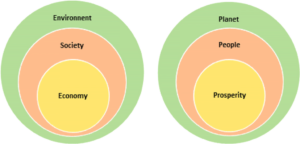Principles and Practices
Sustainable Development

The TerraSeixe Project incorporates the principle of balance in development between the three dimensions of environment, society and economy. To be sustainable, development actions taken by the project should consider all three dimensions equally. Nonetheless, a natural hierarchy exists between these dimensions where the economic dimension is firmly nested within the social dimension. One needs a healthy society to have a flourishing economy. Both the societal and economic dimensions are then nested within the environmental dimension that provides the goods and services necessary for a healthy society and a flourishing economy.
This hierarchal, or linked, dimensional relationship can also be seen as Planet, People and Prosperity, the foundation for the United Nations Sustainable Development Goals or SDGs [1]. The SDGs not only aim to improve people´s lives, these universal goals also aim to ensure a functioning and stable environment within which human activities can take place without degrading the primary source of environmental goods and services, the environment, needed to ensure human wellbeing.
Goal 15: Life on Land, is an important goal for the TerraSeixe Project. This goal aims to ensure i) sustainable forest management; ii) efforts to combat desertification; iii) actions to halt and reverse land degradation; and iv) actions to halt biodiversity loss [2]. To achieve this goal, the TerraSeixe Project aims to create an integrated management plan for the entire project area, the Seixe River Basin. The method for doing this is “land stewardship”, as a participative and collaborative process that involves stakeholders – the people of the Seixe River Basin, including the 3 municipal authorities (Aljezur, Monchique and Odemira) and the regional environmental agencies of APA (the Portuguese Environmental Agency) and ICNF (the Institute for Nature Conservation and Forests).
Land stewardship
Land stewardship can be defined as “an effective, participatory and collaborative method to protect nature”. Here nature means local biodiversity and ecosystems, both important elements of nature-provided (environmental) goods and services, also known as ecosystem services [3]. These goods and services include food and timber, clean air and water, as well as fertile land. To achieve the goal of protecting nature, the TerraSeixe Project has identified the Natura 2000 network that exists within the Seixe River Basin as the basis for providing these ecosystem services.
Natura 2000
The practice of the TerraSeixe Project is to restore and recover the functionality of the Natura 2000 network [4, 5] within the river basin as part of the land stewardship agreements with stakeholders. The Natura 2000 network forms the backbone for the European Green Infrastructure Strategy, a strategy that aims to “to develop, preserve and enhance healthy green infrastructure to help stop the loss of biodiversity and enable ecosystems to deliver their many services to people and nature.” [6].
Restoration of this natural network of habitats is a function of the project for developing the Seixe River Basin´s green infrastructure that will support both the social and ecological resilience of this area. A long-term outlook is taken for this purpose, aimed at the recovery of these habitats through the participation and collaboration of local landowners, supported by the 3 municipalities and the regional ICNF office.
REFERENCESS
[1] United Nations Sustainable Development Goals [online]. Available at: https://sustainabledevelopment.un.org/sdgs.
[2] United Nations Sustainable Development Goals: Goal 15 – Life on Land [online]. Available at: https://www.un.org/sustainabledevelopment/biodiversity/.
[3] Millennium Ecosystem Assessment (2005). Ecosystems and Human Well-being: General Synthesis. Washington DC: World Resources Institute.
[4] European Commission (2018). Natura 2000 [online]. Available at: https://ec.europa.eu/environment/nature/natura2000/index_en.htm.
[5] ICNF: Natura 2000 [online]. Available at: http://www2.icnf.pt/portal/pn/biodiversidade/rn2000.
[6] European Commission (2016). The EU Strategy on Green Infrastructure [online]. Available at: https://ec.europa.eu/environment/nature/ecosystems/strategy/index_en.htm.
Seen as improvement in the quality and quantity of people´s lives. Sustainable development links these measures to a balanced approach to development that provides benefits for both current and future generations.
Defined as “…the benefits people obtain from ecosystems” (Millennium Ecosystem Assessment, 2005).
Cultivating the capacity of both the social and ecological systems in the river basin as a means for sustaining local development in the face of change, either as expected change (planned), as unexpected change (disasters, such as wildfires) and change as a trend over the long term, for example climate change and land degradation (see: C. Folke (2016). Resilience. Framing concepts in Environmental Science [online]. Available at: https://is.gd/ABgHch).


